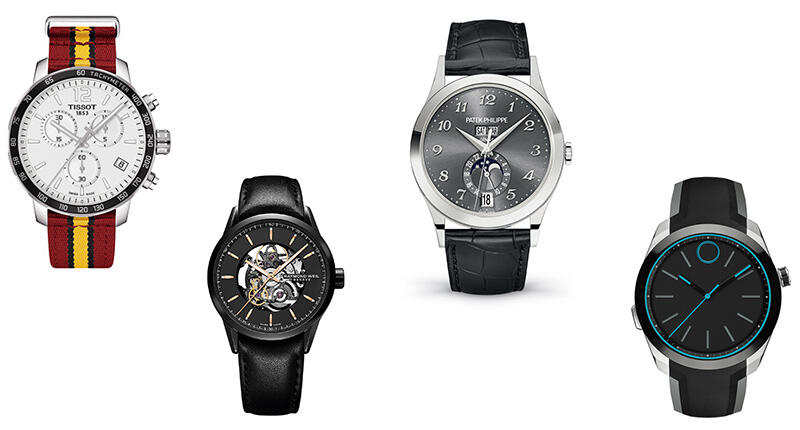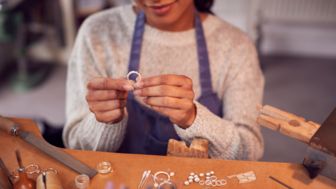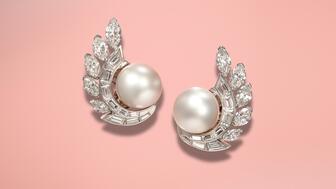The entrepreneur and “Shark Tank” star will share his top tips for success.
How to: Sell More Watches
Experts share the best answer to the question, “Why do I need a watch when my phone tells the time?” and tell jewelers why they should carry smartwatches.

New York--With the world’s biggest watch show wrapping up in Basel, it is the perfect opportunity for jewelers to review strategies for selling both quartz and mechanical timepieces as well as smartwatches.
With just a few tips from industry experts, jewelers can avoid pitfalls, properly train staff and employ sales tactics that will keep customers coming back for watches time and time again.
To start, creating the right atmosphere is key to a successful sale.
A watch purchase, like a fine jewelry purchase, is an emotional one, said Steven Kaiser, owner of Kaiser Time Inc., a consulting and executive recruiting firm for the watch and jewelry industry.
“One mistake retailers make is not creating the full experience for the consumer,” he said. “This includes having an educated staff that has the ability to understand their clientele and offering a full assortment of brands, as well as an upscale and updated environment that reflects the products being sold.”
Without these elements, buyers are more likely to make the purchase online.
Training staff frequently and in a consistent manner also is crucial to selling watches in any brick-and-mortar store, experts said.
Gretchen Mathews, senior vice president of human resources at watch retailer Tourneau, said the best way to train salespeople on quartz and mechanical timepieces is a combination of interactive training and online courses that require testing.
She suggests looking to training provided by the Foundation of Haute Horlogerie, or FHH, the organization started in Geneva in 2005 to provide training and disseminate information about Swiss watchmaking and watch brands.
Courses on watches and watchmaking are particularly useful as some even offer hands-on elements, like the opportunity to disassemble and reassemble a basic mechanical movement.
Retailers also can see what watch brands have to offer authorized dealers when it comes to training, as many have effective training programs that can be done either on-site or online.
Aside from being technically educated on the intricacies of quartz, mechanical and smartwatches, Kaiser said sales staff need to romance the purchase by sharing the history of the brand and by telling personal stories that resonate with potential buyers.
“The ability of the salesperson to key in on the emotional part of the purchase is in many cases just as important as the technical aspects of the timepiece itself,” he said.
One of the many challenges inherent in selling watches--and jewelry, for
To the consumer who asks, “Why do I need a watch when my phone tells the time?” Mathews said the best answer is to physically put a timepiece of interest on that potential customer’s wrist. “Phones do tell the time, but nothing will ever replace the feeling of having a beautiful timepiece on your wrist,” she said.
Jewelers also need to tap into the meaning of a watch purchase to this age group. “For the younger generation, watches have become a status symbol and less of a timekeeping instrument,” said Kaiser.
A retailer’s goal, he added, should be to capture the consumer by selling them a watch as a rite of passage for a young professional. In doing so, the hope is that the consumer will continue to return for a new timepiece as they grow professionally.
Retailers also can play a role in teaching millennials about quartz and mechanical watches, said Haygo Demir, a Miami-based distributor to retailers in the Caribbean.
“Introducing young people to watches and their craftsmanship is important,” he said, adding that perhaps today’s retailers are not doing enough to educate young consumers and can engage this target group by holding open house events and seminars.
When it comes to the question of whether or not smartwatches belong in a traditional jewelry store the answer, sources said, is a resounding “yes.”
Demir said offering smartwatches is not only a must for success in the watch industry but provides an opportunity to attract younger customers. Smartwatches should not be viewed as replacing quartz and mechanical timepieces, but rather as creating new customers.
Training sales staff to sell smartwatches, Kaiser said, is no different than training them to sell a technical timepiece.
Finding the associates on the sales team who best understand the product and relate to the customer is one way to approach selling smartwatches. Allowing the sales professional to try out the timepiece is the best way to ensure they fully understand its capabilities.
“When they present it to a client they can personally walk them though all the functions because they have already had a test run,” Mathews said.
5 Simple Tips for Selling More Watches
1. Create the right atmosphere. Make sure your store is an upscale and updated environment that reflects the kind of watches you carry.
2. Train staff frequently and consistently. One place to start is the training offered by the Foundation of Haute Horlogerie. Watch brands also might have programs in place for authorized dealers that can be done in person or even online.
3. But don’t forget to also romance the watch. Make sure salespeople are well versed on the history of the brands they are selling so they can share that information with customers. Also, encourage them to share personal stories about watch brands that will resonate with buyers.
4. Put the watch on their wrist. This is the best answer to the question asked by many younger consumers, “Why do I need a watch when my phone tells the time?”
5. Carry smartwatches. They're not a replacement for quartz and mechanical watches but, rather, a tool that can attract a different type of clientele.
The Latest

The Ukrainian brand’s new pendant is modeled after a traditional paska, a pastry often baked for Easter in Eastern European cultures.

The jeweler has announced a grand reopening for its recently remodeled location in Peoria, Illinois.

The “Strong Like Mom” campaign features moms who work at Tiffany & Co. and their children.


Interior designer Athena Calderone looked to decor from the 1920s and 1930s when crafting her first fine jewelry collection.

During a call about its full-year results, CEO Efraim Grinberg discussed how the company is approaching the uncertainty surrounding tariffs.

Bench jewelers spend years honing their skills, Jewelers of America’s Certification validates their talents.

The free program provides educational content for jewelry salespeople and enthusiasts to learn or refresh their diamond knowledge.

The feedback will be used to prepare other jewelers for the challenges ahead, the organization said.

The online sessions are designed to teach jewelers to use AI tools like ChatGPT and Claude to grow their business.

The opening marks the jewelry retailer’s first location in the Midwest.

The “United in Love” collection offers tangible mementos of hearts entwined with traditional and non-traditional commitment heirlooms.

Robert Goodman Jewelers will hold a “Black Jewelry Designers and Makers” event on April 27.

The announcements follow a tumultuous start to 2025 for WJA, which saw a wave of resignations following controversial statements about DEI.

Editor-in-Chief Michelle Graff answers questions about how the new taxes levied on countries like India and China will impact the industry.

Kenewendo, Botswana’s minster of minerals and energy, discusses closing the deal with De Beers and the work that was missed along the way.

The historic fancy vivid blue diamond set to headline Christie’s Geneva sale next month could sell for up to $50 million.

LVMH CFO Cécile Cabanis also discussed the effects of tariffs so far.

The “Mad Men” and “The Morning Show” star steals jewelry, art, and handbags from his wealthy neighbors in “Your Friends & Neighbors.”

The organization has reelected Kalpesh Jhaveri as president.

An investigation found that the former managing director of Movado’s Dubai branch overstated and prematurely recorded sales.

The collection pays tribute to the Japanese philosophy of Ma, studying balance, stillness, and the interplay between presence and absence.

Mari Lou’s Fine Jewelry in Orland Park, a suburb of Chicago, is closing its doors.

GIA’s labs in Dubai and Hong Kong are now accepting larger diamonds in light of the “logistical challenges” presented by the new tariffs.

These earrings by Van Cleef & Arpels, featuring the same design as a pair worn by Princess Grace, are up for auction at Woolley & Wallis.

Two experts share how artificial intelligence tools can help retailers run a more efficient business.



























